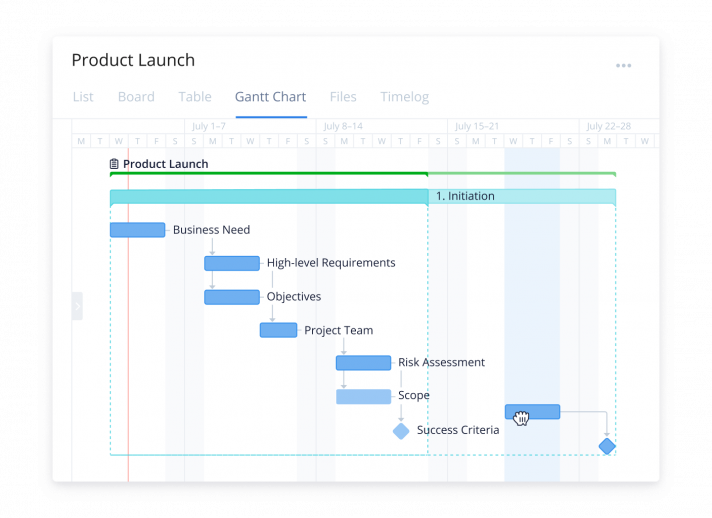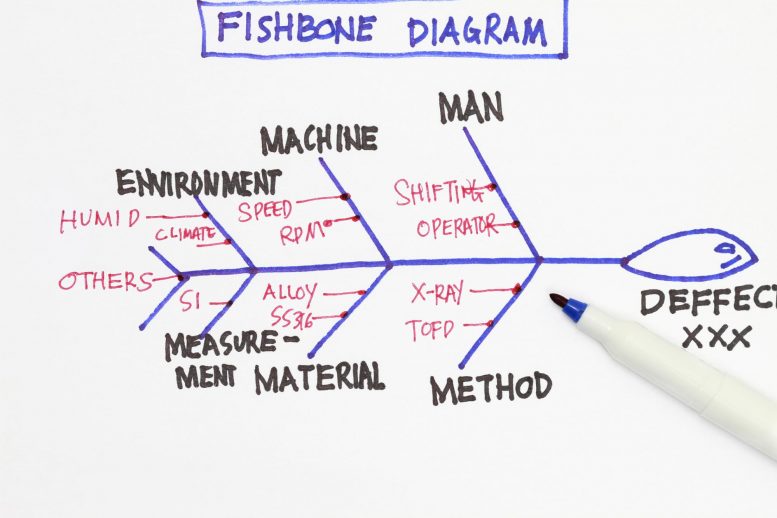Key takeaways:
- What is root cause analysis? It’s a problem-solving process that identifies and resolves core issues, rather than just symptoms, to enhance project success.
- Why is root cause analysis important? It addresses the root of problems, preventing recurring roadblocks that can derail projects and improve efficiency.
- What are the benefits of using root cause analysis? It boosts team capabilities, enhances project outcomes, improves efficiencies, and delivers better customer experiences.
- What are common root cause analysis techniques? The Fishbone diagram and 5 Whys method help uncover core issues effectively.
- How can Wrike assist in root cause analysis? Wrike centralizes communication, tracks action items, and offers visual Gantt charts to streamline the RCA process.
Are you struggling with a potential roadblock in your project? Every project goes through its fair share of issues that can be challenging to resolve. In these situations, it’s important to identify and fix the problem, and not just the problem’s symptoms.
Performing a root cause analysis can be a great option and, with the help of a root cause analysis template, you can create a repeatable and effective problem-solving structure.
So, let’s look at root cause analysis in detail - from benefits to examples.
What is a root cause analysis?
A root cause analysis is a problem-solving process where several resources, including tools, techniques, and diverse methods help you identify and resolve core issues or problems.
Root cause analysis focuses on defining the problem by digging into its origins and then taking steps to eliminate the core problem.
Understanding how to perform a root cause analysis using a root cause analysis template can help your project teams stay on track and nip any project issues in the bud.
Why is it important to perform a root cause analysis?
If you have a problem at work, how do you solve it? Do you prefer to address that single issue or get to the root of the problem to prevent future roadblocks?
Performing a root cause analysis will help you address and eliminate the main problem by identifying what’s causing it in the first place. Not doing this on time could lead to reoccurring issues that may derail the project.
What are the benefits of root cause analysis?
There are many benefits to performing a root cause analysis. It is often one of the most effective form of problem-solving when it comes to identifying process or personnel bottlenecks. Let’s review the benefits of doing a root cause analysis:
- Identifying the core issue or problem that your team member may be struggling with
- Improving process efficiencies within the organization
- Boosting team capabilities and confidence to handle a particular project
- Innovating a new problem-solving approach or solution to prevent the problem
- Improving individual or team performances and results
- Delivering better quality project outcomes than before
- Being able to complete and deliver projects faster than before
- Delivering an outstanding customer experience
Root cause analysis example
Let’s look at the following situation as a root cause analysis example:
After a weekend away from a package fulfillment center, the shift manager returns to discover some of the products have been damaged and are no longer in working order due to a flood in the basement.
After further investigation, a burst pipe is determined to have caused the flood. Even still, this is not the main reason for the damage, but rather a symptom. When a plumber inspects the pipes further, he detects extensive corrosion caused by a failure to update and replace them after decades of use.
The root cause in this example is the worn-out infrastructure within the building. By carrying out a root cause analysis, the company can take steps to upgrade this infrastructure and avoid similar incidents in the future.
Root cause analysis steps
Based on the nature, scope, and complexity of the problem, your team can choose from the many available root cause analysis methods.
Starting the root cause analysis with a step-by-step approach using pre-made templates lets you identify the problem and understand it well before proceeding towards its resolution.
- Assemble the team: Before starting the RCA process, take some time to identify the most knowledgeable team members and give them the resources they need to begin the root cause analysis. Consider the nature and scope of the issue and the individual team member’s strengths before forming the team.
- Pinpoint the issue: Once you have the RCA team ready with the right resources, it is time to put the spotlight on the real problem. Let’s take the same example as outlined above for simplicity. A flooded basement that destroyed products is the issue here. To identify the real problem, dig a bit deeper. Ask questions to find out what exactly happened and how.
- Discover the root cause: On reviewing the problem closely, your team members will come up with the real reason or the root cause why the problem occurred in the first place. By using popular root cause analysis templates and methods such as the 5 Whys or a Fishbone diagram, they will be able to uncover the real reason for the problem.
- Get the solution rolling: By using a root cause analysis template, the cause comes to the forefront. Now, it is time to resolve the issue by choosing the best possible plan of action. Make sure you have a problem-solving checklist that includes the participants, timelines, steps, and parameters to confirm that a solution is executed successfully.
- Validate the outcomes: Is the corrective action for the problem taken or planned for execution at a later date? Awesome! It’s time to stop and validate whether the problem has been completely fixed or will be resolved shortly. Record the actions taken along with their successful outcomes for future reference. Let the team know if the solution was a complete fix or solved only partially. In this case, your team will need to keep a close eye if the partially solved issue has the potential to impact other interrelated projects or team deliverables.
Root cause analysis templates
A root cause analysis template is essentially a diverse problem-solving method. Some of the most well-known root cause analysis templates are the Fishbone diagram and the 5 Whys technique. Both methods have their own unique approach, strengths, and limitations. Additionally, Gantt charts can also serve the purpose of an RCA template.
Fishbone Diagram
If you prefer using a visual problem-solving technique, consider using a Fishbone diagram, also known as an Ishikawa diagram. This type of diagram enables you to create a simple but visual map with small fishbones that signify the problem’s potential causes.
Your team starts with the core issue in the middle of the Fishbone and then brainstorms the possible causes placed in the little fishbones that emerge as an offshoot from the main one.
By digging deeper, the root cause is revealed along with other related or correlated factors that may have led to the main issue. Making a Fishbone diagram (or a Cause-and-Effect Diagram) is also a great way to eliminate unrelated causes and lets you focus on the issues threatening to derail your project.
The 5 Whys
Cut the fluff by using the 5 Whys problem-solving technique. If you are struggling with recurring issues that simply refuse to go away, this method may help you identify the real problem. Sakichi Toyoda first popularized this method by using it to solve shop floor issues at his company, Toyota Motors.
In this simple root cause analysis technique, the question "why" is asked five times until the problem’s origin or core is identified. Think like you’re peeling an onion to reveal its superficial and top layers and then reaching the center of it. If you’re dealing with a recurring issue or a relatively simple problem, pick the 5 Whys analysis to find and solve the issue once and for all.
Gantt charts
Gantt charts are generally used in project management to visually represent tasks and their timelines. However, they can also be used as a root cause analysis template.
Breaking down an issue into its underlying causes and mapping them out in a Gantt chart results in a powerful RCA template. The chart illustrates the sequence of events that led to the problem and the correlation between different causes.

Additionally, a Gantt chart can help with tracking the progress of the root cause analysis process and ensure that all relevant causes are addressed.
Top tips for root cause analysis success
Do you want your team to succeed? Support them in asking the right questions that can take them closer to the answers. Asking the right questions helps them get closer to the potential solution and quickly find the root cause of an issue.
Work as a team
Having an extra set of eyes always helps. Apart from removing unintentional biases, the end result is more holistic and offers a diverse set of solutions to choose from.
Forecast the future
Being in the moment is vital, but it is also important not to lose sight of the big picture. While performing a root cause analysis, stay aware of the process in the context of your specific situation and future business requirements.
Analyze team successes
If team problems are reviewed closely, shouldn’t successes be minutely mapped too? RCA is a wonderful method to identify what’s going right in your organization, find its root cause, and make sure that more successes follow!
In fact, by analyzing root causes of successes, your team can actually adapt processes so that these wins happen more often and across the organization.
Why use Wrike as your root cause analysis tool?
Solving problems may be challenging, but carrying out a root cause analysis within Wrike can help. Share your RCA findings using Wrike as a centralized communication hub and keep everyone on the same page and solving problems together.
Wrike helps your team members keep track of action items with shared tasks, customizable dashboards, and automated status reports. You can easily conduct your root cause analysis using the Gantt chart feature on Wrike. It will set the problems into a timeline and help you perform your analysis in a powerful visual form.
Start a free two-week trial to see how Wrike can help you successfully perform an effective root cause analysis, solve potential problems, implement solutions, and boost project outcomes.










